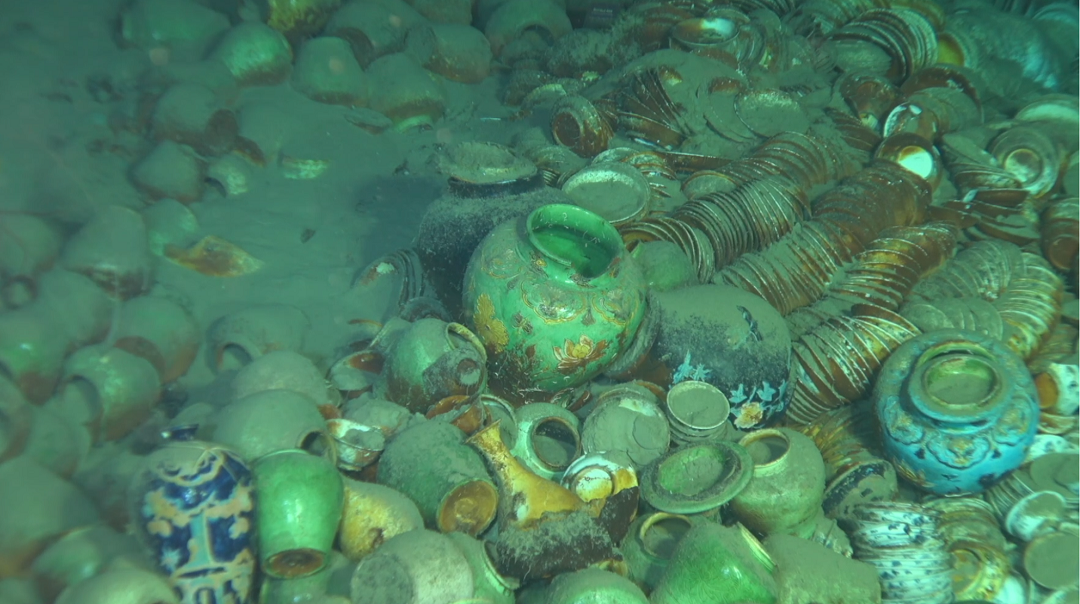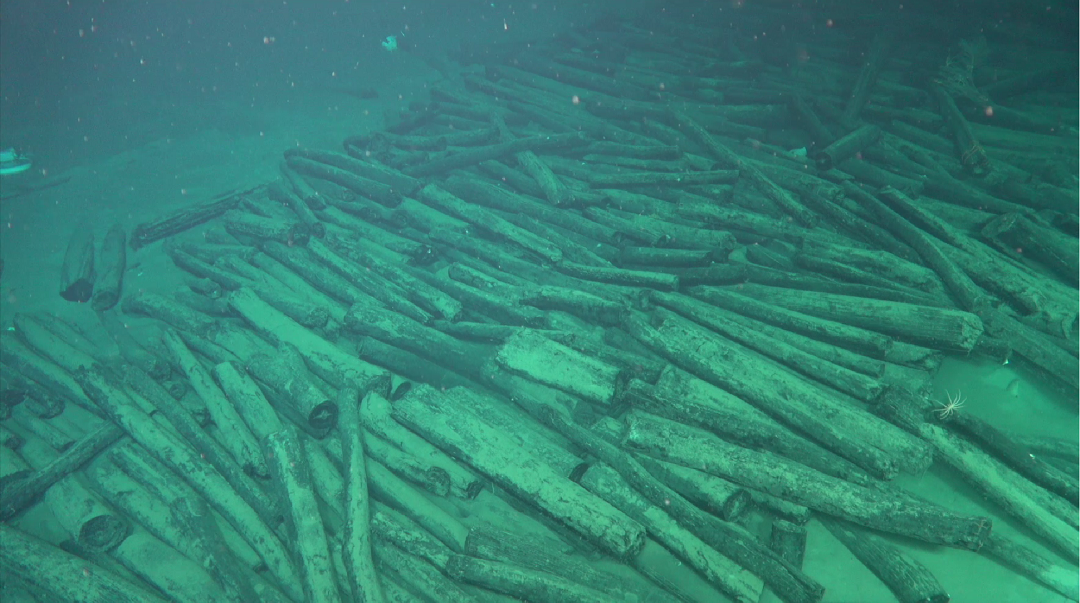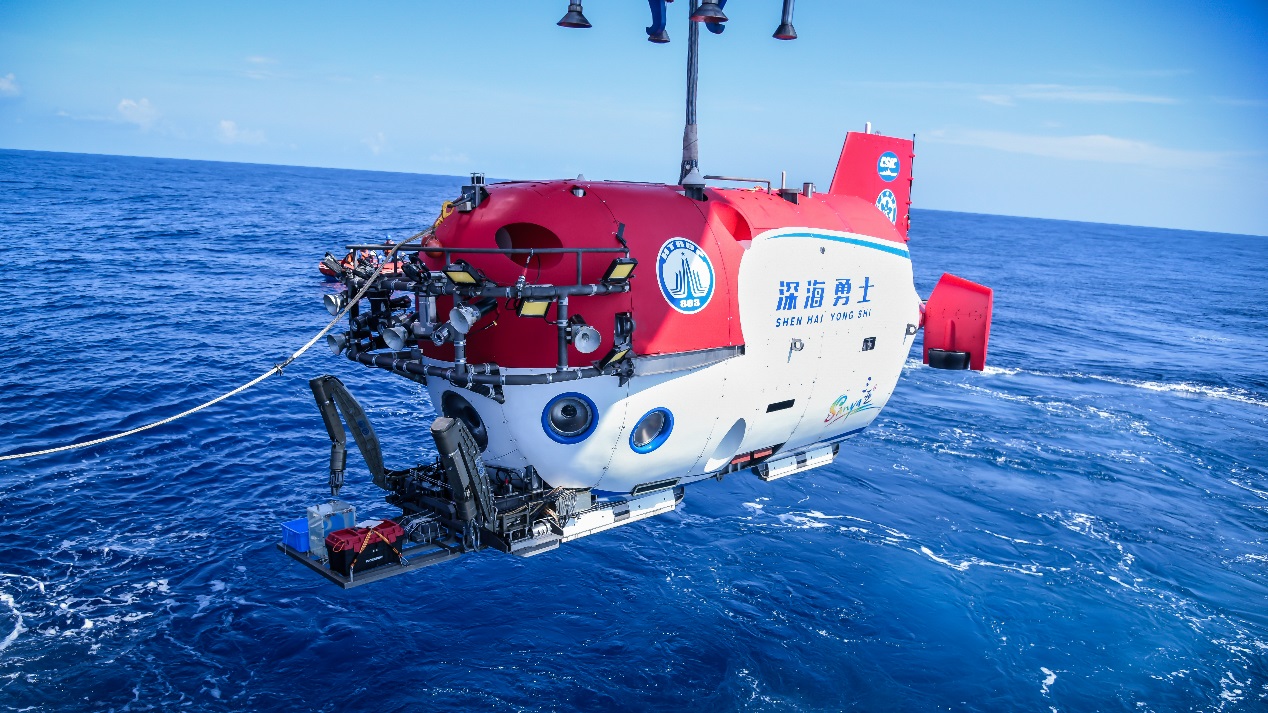
Porcelain wares found at a shipwreck in the South China Sea. /National Cultural Heritage Administration
Porcelain wares found at a shipwreck in the South China Sea. /National Cultural Heritage Administration
Editor's note: This is the first article of a series covering the discovery of two Ming Dynasty shipwrecks in the South China Sea. CGTN will write more about the topic according to the archaeological research progress.
About 1,500 meters below sea level, a team of scientists in a Chinese submersible was amazed by what they saw while conducting deep-sea research in the northwest slope of the South China Sea.
A three-meter-high hill of porcelain wares, once a popular Chinese commodity in international trade, emerged before their eyes.
Putting excitement aside, the team realized it might be a site of an ancient shipwreck. There's more deep into the blue. About a dozen nautical miles (nearly 20 kilometers) away, another shipwreck of countless wood logs was quietly and neatly scattering on the seafloor.
The two sites were discovered by scientists from the Institute of Deep-sea Science and Engineering (IDSSE) of the Chinese Academy of Sciences (CAS) on October 23, 2022.
On May 21, a press conference was held in Sanya, South China's Hainan Province, introducing the world-class discovery and kick-starting the archaeological research.

Wood logs found at a shipwreck site in the South China Sea. /National Cultural Heritage Administration
Wood logs found at a shipwreck site in the South China Sea. /National Cultural Heritage Administration
What's on the ships?
Chen Chuanxu, deputy director of the institute, said during the press conference that the discovery happened on the 500th mission of the Shenhai Yongshi (Deep Sea Warrior), China's self-developed manned submersible that can dive as deep as 4,500 meters.
"This is the first time we are involved in a large-scale, deep-sea archaeological research. We've conducted a series of on-site exploration missions, and I dived down there, too. Simply put, I was quite excited and shocked as well," Chen said.
According to China's National Cultural Heritage Administration (NCHA), the first shipwreck dates back to the first two decades of the 16th century, during the reign of Emperor Zhengde in the Ming Dynasty (1368 -1644). The "hill of porcelain wares" has been roughly estimated to be at least 100,000 pieces of cultural relics.
The second site dates back to the late 15th century, during the reign of Emperor Hongzhi in the Ming Dynasty. Unlike the first ship, it was heading to China, loaded with logs imported from overseas.
"The wrecks are both relatively well-preserved, and a large number of relics have been uncovered," said Yan Yalin, director of the archaeology department of NCHA.
The discovery not only unveiled tragic stories about two merchant vessels but also more proof of the maritime trade history in the South China Sea.
An important trade channel in Southeast Asia, the South China Sea has witnessed how the ancient Maritime Silk Road flourished, especially after the Tang Dynasty (618-907). With wrecks on its sea floor, the South China Sea has also become the birthplace of underwater archaeology in China.

The deep-sea manned submersible Shenhai Yongshi (Deep Sea Warrior). /Institute of Deep-sea Science and Engineering, Chinese Academy of Sciences
The deep-sea manned submersible Shenhai Yongshi (Deep Sea Warrior). /Institute of Deep-sea Science and Engineering, Chinese Academy of Sciences
Studying shipwrecks
Compared with archaeological sites on land, shipwrecks could provide a more comprehensive historical picture, especially those that rest deep below where humans couldn't easily disturb them.
Cui Yong, a former director of the Guangdong Provincial Institute of Cultural Relics and Archaeology, describes a shipwreck as a time capsule that preserves the true state of life in a particular era.
"A shipwreck shows not only the cargo on the ship but also information about the time era and sailing route, as well as the politics and society at that time," Cui wrote in an article recalling his 30 years of experience studying shipwrecks.
As an archaeological team leader, Cui took part in the whole process of excavating, salvaging and studying the Song Dynasty (960-1279) wreck Nanhai One, a wooden vessel that sank at the end of the 10th century. It was discovered in 1987 and is now housed in a water tank of the Maritime Silk Road Museum in Yangjiang, south China's Guangdong Province.
The two newly found Ming Dynasty wrecks couldn't be lifted out of the sea as archaeologists did with the Nanhai One, which was located at a depth of only 23 meters.
However, with the help of China's scientific research vessels and submersibles, the research team will find out the distribution of cultural relics from the two wrecks and collect representative cultural relics and other seabed samples in the first stage of research, which will be completed as early as mid-June. The three-stage archaeological research is expected to last until April 2024.
Read more:
Deep-sea treasure hunt: Tech breakthroughs enable China's maritime archaeology go deeper